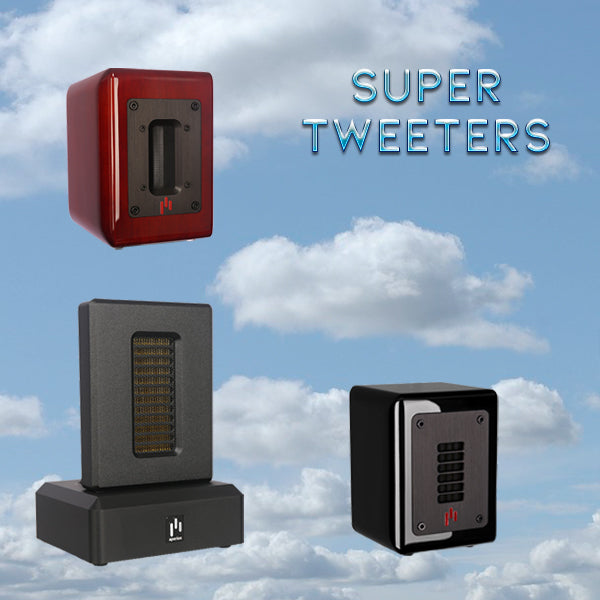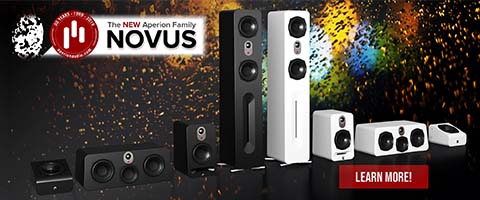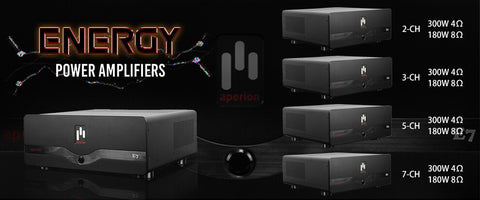The cornerstone of every home theater and many music audio systems is the subwoofer, and home theater owners want to shake every corner of their home theater to its foundation. This quick course of tips and tricks will help you do just that, in the highest possible fidelity. (Note, we are not responsible for noise complaints or neighborhood association ordinances.) After you’ve selected your subwoofer, optimizing its performance actually comes down to just two things: its placement in your home theater and your setting adjustments.

- - - - - - - - - - - - - - - - - - - - - - - - - - - - - - - - - - - - - - - - - - - - - - - - - - - - - - - - - - - - - - - -
Your Room vs. Your Subwoofer
This sounds simple, but when it comes to placing your subwoofer(s), four competing objectives will be vying for attention to the point where you’ll probably need to live with some sort of compromise. Where your subwoofer eventually ends up will affect how evenly the bass gets spread throughout the listening area, how much bass is produced per watt of power, how well its sound waves integrate with those from the rest of your speakers and, of course, whether you like its placement in your home theater. Of course you want the best possible sound. But your wife is right: your subwoofer isn’t making sound most of the time – usually it’s furniture. So unless you want to sleep in your home theater, you may want to take room aesthetics into account. You may also want to consider things like where you can plug it in and how hard it will be to run the wire from your receiver or if a wireless solution is best. Subwoofers are supposed to make life easier, not harder.
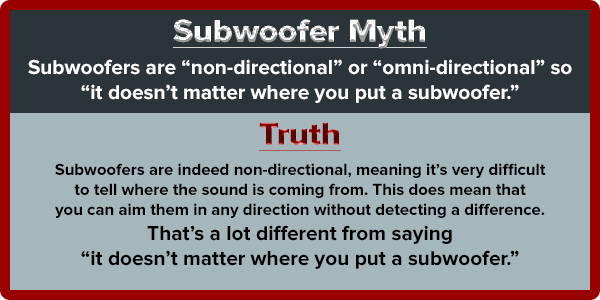
- - - - - - - - - - - - - - - - - - - - - - - - - - - - - - - - - - - - - - - - - - - - - - - - - - - - - - - - - - - - - - - -
Getting the Bass Distributed Evenly Through the Listening Area
Subwoofers are bass specialists. If they could wear a hardhat and carry a clipboard, they would. All sound, of course, is made of waves – with bass being the longest. For example, subwoofers typically output waves that are longer than 12’. The physics of what happens with long waves in rooms is complicated – reflected waves arriving later than non-reflected waves, reinforcing or canceling each other out, other waves doing funny things just because they happen to neatly fit in the room, and more. The result is a pattern of bass-loud and quiet zones distributed throughout your room that will differ for every bass frequency.
- - - - - - - - - - - - - - - - - - - - - - - - - - - - - - - - - - - - - - - - - - - - - - - - - - - - - - - - - - - - - - - -
Fortunately, there are a few things you can do that will help:
-
Place your subwoofer in a corner. By making the three closest reflected paths close in length to the non-reflected path, they all arrive at your ear at pretty much the same time and reinforcing one-another. If a corner is impractical, the next best place is near one wall, the floor and an open area (like a hall) for the same reason except that one of the reflected paths is taken out of the equation. Whew. Just place your subwoofer as close to a corner or wall as you can, and you’ll be fine.
-
Use more than one subwoofer. This way, the pattern of bass from one subwoofer will be different than from the other and likely to even-out the combined bass distribution. This will fill your room with bass and hopefully even out the “dead zones.”
-
If you use more than one subwoofer and they both can’t go in corners, put them in non-similar places relative to walls and open areas. Non-symmetry is good for bass. Not as good as corners, mind you — but still good.
- - - - - - - - - - - - - - - - - - - - - - - - - - - - - - - - - - - - - - - - - - - - - - - - - - - - - - - - - - - - - - - -
Getting the Most Bass With the Least Power
Let’s check out the corners again. Each room boundary (wall, floor or ceiling) you get your subwoofer close to will be equivalent to four times the power going to the same woofer. Close to three room boundaries results in (theoretically) 64 times the bass energy when compared to a subwoofer suspended in the middle of the room! So put your subwoofer in the corner. It will sound better and shake-shake-shake your foundation.
- - - - - - - - - - - - - - - - - - - - - - - - - - - - - - - - - - - - - - - - - - - - - - - - - - - - - - - - - - - - - - - -
Getting Your Subwoofer to Work With Your Other Speakers
Because of the way frequency filters divvy-up what goes where, a range of frequencies end up getting shared by the subwoofer and front speakers. In this overlap-zone, the waves from all these speakers need to add together to produce the proper loudness. They can all be positive contributors to the sound level or, if the peak of one wave meets the trough of another, they can actually end up canceling each other out. Thankfully, you won’t need a calculator, a tape measure or a tenured physics professor to get things right if you follow these two simple recommendations:
-
Make sure the subwoofer has a “phase switch” or knob. The use of this feature will be explained in “Setting the controls” below.
-
It’s best is to keep the subwoofer(s) in the same general area as your front speakers. It’s a-okay to put a subwoofer to the side of the listening area, and very much not okay to place it behind the listening area.
- - - - - - - - - - - - - - - - - - - - - - - - - - - - - - - - - - - - - - - - - - - - - - - - - - - - - - - - - - - - - - - -
Hooking Up Your Subwoofer
If your receiver has a subwoofer output:
-
Run a cable with the appropriate plugs on each end (sometimes called RCA plugs) from the receiver’s subwoofer output to the subwoofer input labeled something like “sub input”, “line in” or “low-level in”. It is best to use a shielded cable for your subwoofer so other pesky signals don’t worm their way into your precious bass.
-
If this cable encounters household wiring, have it cross at a 90-degree angle.
-
Most subwoofers have both a left & right input. It usually doesn’t matter which one you use. Some people will buy a “Y adapter” or “splitter” so that a single cable can feed both subwoofer inputs. There’s no harm in doing this, the reason subwoofers have L & R inputs is so that if you have a stereo pre-amplifier, you can use both “pre-outs” to the subwoofer without losing anything.
-
If you are using more than one subwoofer, you can run the same kind of cable from the subwoofer’s “line out” or “low level out” to the next subwoofer.
- - - - - - - - - - - - - - - - - - - - - - - - - - - - - - - - - - - - - - - - - - - - - - - - - - - - - - - - - - - - - - - -
If your receiver does not have a subwoofer output, you will need a subwoofer with inputs (usually called “high-level inputs” or “speaker level inputs.”)
-
Run speaker wires from your receiver (or your front left & right speakers) to the subwoofer’s high-level inputs. Don’t worry about speaker wire quality (the subwoofer’s amplifier is a resistive load meaning that, unlike speakers, all frequencies will be treated the same.) These high level inputs are not a lower quality input but they will not allow you to use the really cool crossover feature that’s built into most home theater receivers.
-
Since speaker wire is typically unshielded, it’s best to steer clear of household wiring. If it does need to encounter household wiring, have it cross at a 90-degree angle. If your subwoofer emits a buzz or a hum, this may be the culprit.
-
When using more than one subwoofer, its input wires can originate from the receiver, front left & right speakers or the inputs of the first subwoofer. Do not use the “high level outputs” to connect to other subwoofers. We recommend that these high level outputs not be used.
- - - - - - - - - - - - - - - - - - - - - - - - - - - - - - - - - - - - - - - - - - - - - - - - - - - - - - - - - - - - - - - -
Setting the Amp Controls
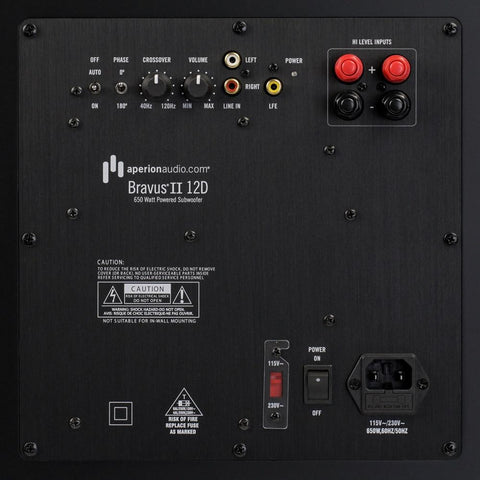
On – Auto – Off: Most listeners like this switch set to “Auto” so that your sub will turn itself on when it receives a signal and fall asleep when not in use. The small light that tells you if the amp is on or not usually takes awhile to confirm when the subwoofer has stopped receiving a signal. Also, just to be safe, turn the knob labeled “volume”, “level”, or “gain” down before turning your subwoofer on.230V – 115V: In America, this will usually be set to 115V. Many parts of the world use 230V for their household power.
- - - - - - - - - - - - - - - - - - - - - - - - - - - - - - - - - - - - - - - - - - - - - - - - - - - - - - - - - - - - - - - -
Crossover frequency / bypass
-
If you’ll be using the crossover built into your receiver (recommended): Use the “bypass” switch if your subwoofer has this feature. Otherwise, turn the “crossover frequency” to the highest possible setting.
-
If your receiver does not have a built-in crossover (or you’re not using it): Your front left & right speakers extend down into the bass but begin to peter-out at some point. This frequency should be specified in the speaker’s owner’s manual or on their website as the lower limit of the speaker’s range. Set the subwoofer’s “crossover frequency” to this frequency (or maybe a little higher since a lot of liberties are taken with this specification). Later, you can fiddle with this control to hone in on the best setting.
- - - - - - - - - - - - - - - - - - - - - - - - - - - - - - - - - - - - - - - - - - - - - - - - - - - - - - - - - - - - - - - -
Volume (aka Level or Gain) : For starters, turn this to a comfortable level. Final adjustments will be made later.
Phase: The easiest way to set the phase switch (or knob) is with a steady bass tone. Best is if you have a special test CD or DVD that has “pink noise” or, better, a constant bass tone around the crossover frequency (usually 80 Hz if you’re using a home theater receiver). If you don’t have anything that can produce pink noise, pick a favorite music track that has a constant, prominent bass line. Now, hire an assistant or have a friend move the phase control back and forth while you’re evaluating the sound in your listening area. Settle on the control position with the most bass. For now, don’t worry about which setting has the best bass, just the most. If this control is a 2-position switch, it’s possible that there will be no difference between the two positions (expected when the sub is about 3’ closer or further from you than the front speakers), in which case either position is fine.
Finally : Re-adjust the subwoofer’s crossover frequency (if you’re using it instead of the preferred crossover built into most receivers) and volume settings to where you think the sound is best. Listen for a solid, robust bass that is tight, well controlled and clear without “tubbiness” or “muddiness”. To get the subwoofer’s output at the same level as the front speakers you can use your ear or a sound level meter and test CD. You’ll probably find yourself making additional fine adjustments over the next few weeks as you listen to a variety of material.
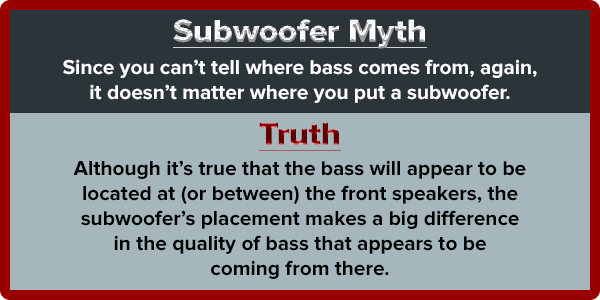
Room treatment : This is a big topic. We could spend weeks addressing this important and often overlooked subject. The main thing to know is that normal rooms can be made to work well using ordinary furniture, like couches, rugs and bookcases that effectively absorb and scatter the sound.
- - - - - - - - - - - - - - - - - - - - - - - - - - - - - - - - - - - - - - - - - - - - - - - - - - - - - - - - - - - - - - - -
In Conclusion
With a little patience and attentive listening, you can make your bass performance rival the most expensive systems. Refer back to this document, trust your ears and above all, have fun!
Written by author and audio professional Ken Humphreys, Speaker Engineer
For more information on our subwoofers, check out this size comparison video. Please feel free to give us a call at 503-598-8815 or live chat with us.

Complete Your Sound System Solution

Sign up for our newsletter below, and join our social media groups to stay up to date with the latest news and information from Aperion Audio!
 |
 |
